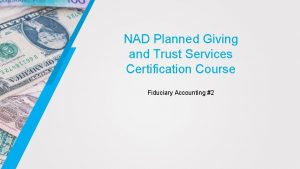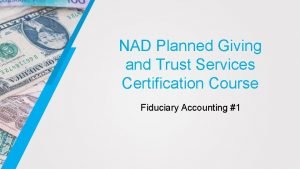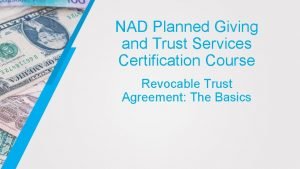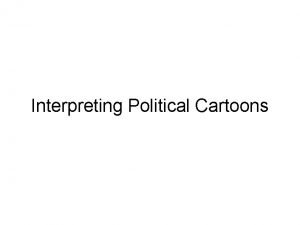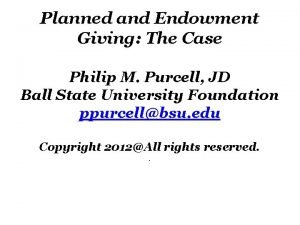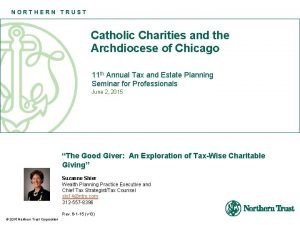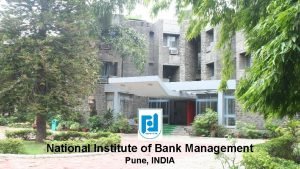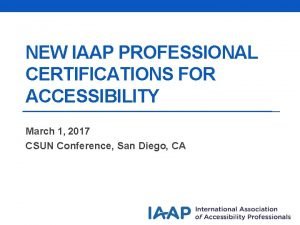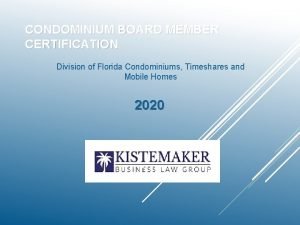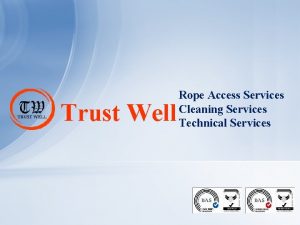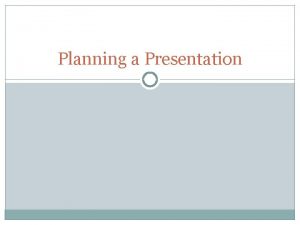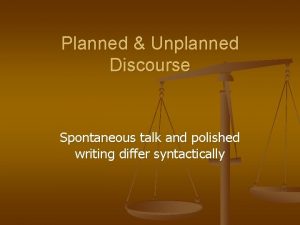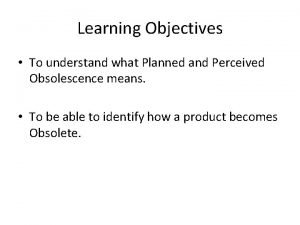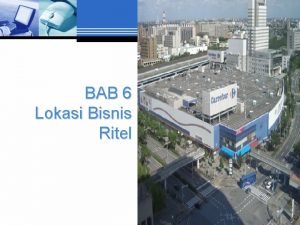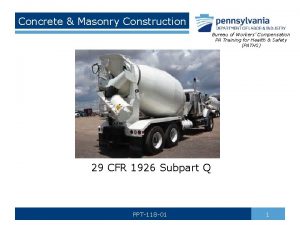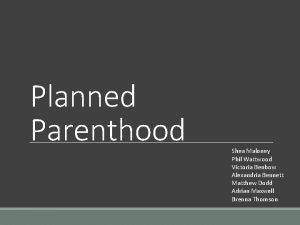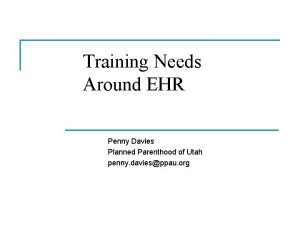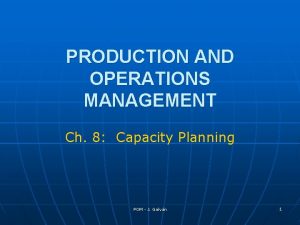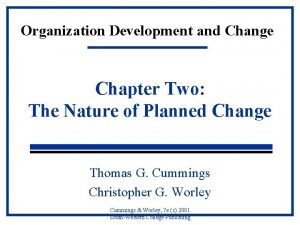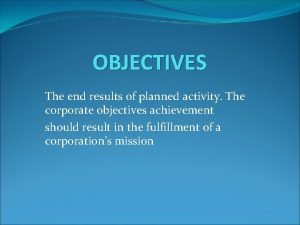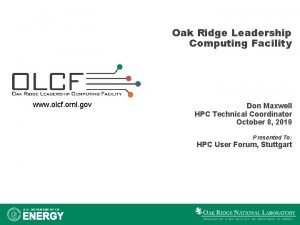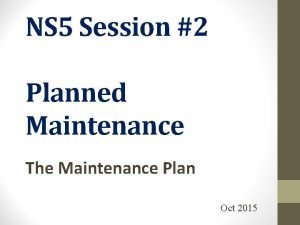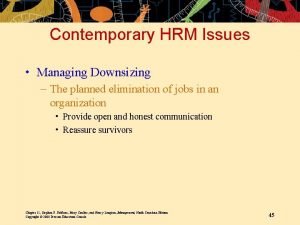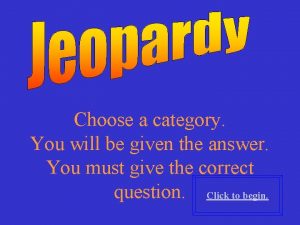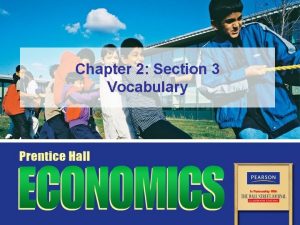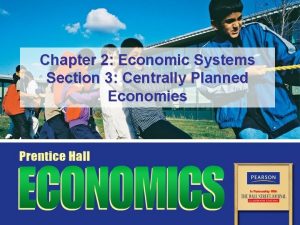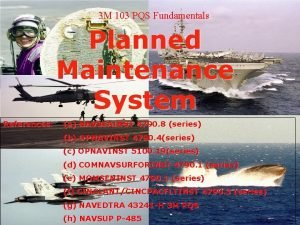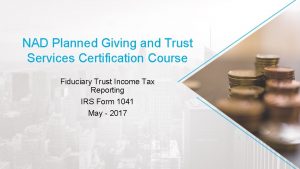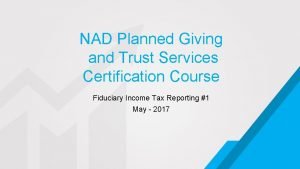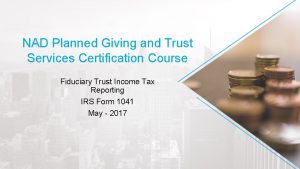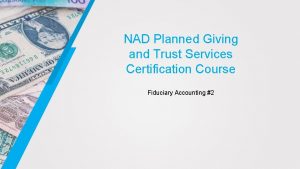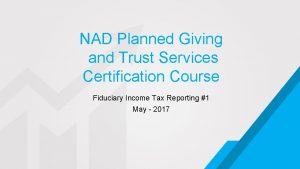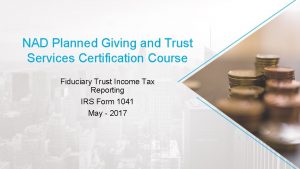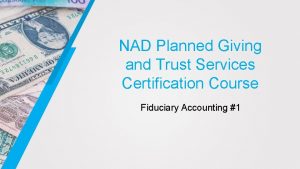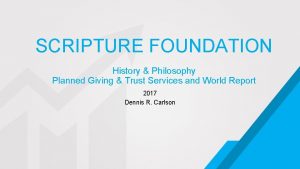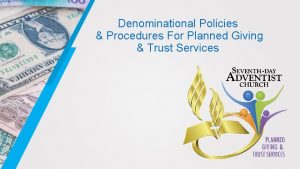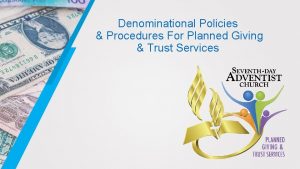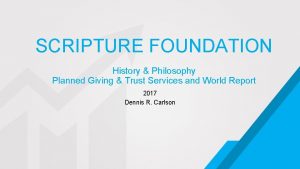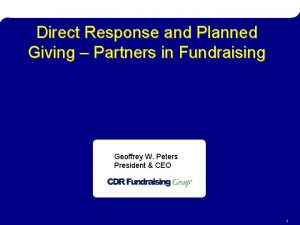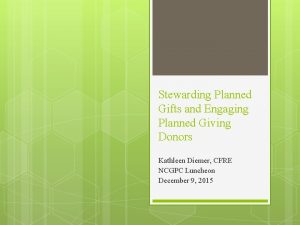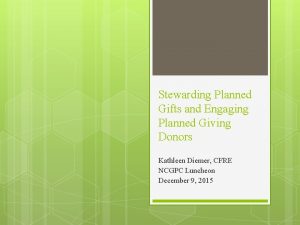NAD Planned Giving and Trust Services Certification Course



































- Slides: 35

NAD Planned Giving and Trust Services Certification Course Revocable Trust Agreement: The Basics

Lesson Summary • This lesson covers the basics of the Revocable Trust Agreement, which is a very useful estate planning option that generally allows decedent’s properly titled trust assets to avoid probate. • What do I need to know? • It would help the student to be somewhat familiar with Wills, Probate, Trusts and the basic terminology. • What will I learn in this lesson? • Creation, Benefits, Essential Elements and Tax Consequences of the Revocable Trust Agreement

Learning Outcomes Following this lesson the student will be familiar with: • The definition of a RT • The Five Essential Elements of a RT • Tax Consequences

Suggested Books or Resources • Planned Giving & Trust Services Manual Chapter 13 • The Executor’s Guide. Settling a Loved One’s Estate or Trust. 7 th Edition

5 Essential Trust Elements A = A written trust agreement is written for the B = Benefit of the beneficiary, by the C = Creator who appointed a T = Trustee to steward the trust P = Property

5 Essential Trust Elements Players Agreement – the trust document Beneficiary – those that benefit from the provisions of the trust Creator – Anyone over the age of majority of sound mental capacity Trustee – a fiduciary who manages trust assets Property - transferred property – trust corpus, or principle

Types of Beneficiaries 1. Income Beneficiaries 2. Remainder Beneficiaries

Elements of a Trust Agreement A – The names of the trust creator and initial trustee B – The grantor’s expression of intent to create a trust C – The statement of intent to transfer property to the trustee and the agreement by the trustee to accept such property D – Whether the grantor or anyone else may amend or revoked the trust, add or withdraw assets E – Identity of successor trustees, conditions under which and in what order the successor trustees would serve

Elements of a Trust Agreement F – What power trustees should have in terms of investment and management, and what discretion the trustee is to have in terms of releasing money or other property to beneficiaries G – Identity of the primary trust beneficiaries H – Who is to receive distribution of the trust estate upon the death of the grantor I – When the beneficiary would be entitled to receive the distributions J – Statement of governing state law

PGTS = Planned Giving and Trust Services RT = Revocable Living Trust Also known as RLT = Revocable Living Trust

Benefits of a Revocable Trust (RT) • Generally, Trust Assets Avoid Probate • May result in cost savings • Assets are distributed quicker

Trustee Duties • Liquidating assets • Determining and paying final expenses • Filing tax returns • Paying creditors • Locating beneficiaries • Making distributions

Trust documents are not normally filed with the court and is more likely to remain a private document.

A trust can avoid the need for a court appointed guardian or conservator by providing uninterrupted administration to a grantor who is disabled or incapacitated.

A trust is not subject to the rules of probate and is more difficult to challenge in court

When is a Trust Created? • When one party, the grantor, transfers property to a trustee • Property is transferred for the benefit of a third person • The grantor retains the right to specify the responsibilities of the trustee • Can be created by • • • a will a testamentary trust between two parties while living by an inter vivos trust or living trust declaration of trust

The Creator of a Trust is known as a… • Grantor • Trustor • Or Settlor And Transfers property to another to hold for a specified purpose

Creator of a Trust • Must be an adult under state law (usually 18 years or older) • Must have mental capacity • Must understand the implications of the document • Must know the nature and situation of the property that is involved • Must understand the beneficiaries of the trust • Must have the ability and freedom to act independently

Trustee • A fiduciary who manages the trust assets pursuant to the directions in the trust agreement and applicable law • Trusted to take care of the trust property and to do what the trust instructs • Acts solely for the benefit of trust beneficiaries • Be thoroughly familiar with the provisions of the trust document and to follow them implicitly

A Trustee may be a • Person • A bank • Another corporate trustee • Charitable Corporation • Combination of these

• In the past it was common that a church member would name the Seventh-day Adventist Church Organization as their trustee • However, it is becoming more common for church members to name themselves as the initial trustee with another person, bank, corporate trustee, or the church organization as the successor trustee to assume office upon the death or disability of the grantor. • This is often referred to as Self-Trusteed or a Self-Administered Trust.

Capacity to Serve as Trustee • Must have legal capacity to hold property • Must be of majority age • Some states require residence in the state

Fitness to Serve as Trustee • • • Adequate Mental Capacity Ability to safeguard assets Handle Financial Transactions Engage in Investment Functions Perform Accounting and Tax Reporting Duties Commitment of time, monetary and staffing resources to assure that trustee duties are properly performed • Able to Manage Complex Relationships

Trust Property • Transferred property is usually called trust corpus, or principle • Generally, the trust cannot exist without property • Some jurisdictions allow an inter vivos trust to be initially funded by a transfer of property at death, either through a will or through beneficiary designations

Transferred Property Can be any type of property capable of ownership transfer, such as • Cash • Securities • Bank Accounts • Real Estate • Tangible Personal Property • Contract Ownership

Split Ownership of Property Trustor Holds the Equitable Right to the Property Trustee holds the Legal Title

• Equitable Rights of Trust Assets Involve the right to Use, Enjoy, and Benefit from trust assets • For example, the grantor may receive trust income and occupy trust real estate

Holding Legal Title of Property in a Trust • In Some Jurisdictions legal title of property may be held in the name of the trustee without referencing the name of the trust • For Example – General Conference Corporation of Seventh-day Adventists • But it is generally preferred for title to be held in the name of the trustee as trustee of a specifically named trust • For Example – General Conference Corporation of Seventh-day Adventists, trustee of the John and Mary Doe Trust

Holding Legal Title Includes • Possession and control of the asset or title document • Right to transfer ownership

Comingling of Assets • It is absolutely essential that assets of the trust are kept separate from the trustee’s personal or corporation owned assets • Mingling the trust funds with funds belonging to the trustee is a breach of trust • Many states prohibit comingling, and some consider it to be a criminal act

Beneficiary • The person for whose benefit the trust exists • Must be specific (named individually) or described sufficiently to be definite (e. g. the children of the grantor then living) • Must be identifiable before the termination of the trust

Income Beneficiaries • Mandatory Interests, meaning all income must be paid out at least once a year • Discretionary Interests, leaves the decision to the trustee to pay out all or part of the income in a given period • Income retained in the trust is usually added to the trust principle and reinvested • It is common for the trustor to be the income beneficiary during their life • A trust could name another individual, class or organization to receive trust income • Some beneficiaries have the right to withdrawal trust principle

Remainder Beneficiary • Takes the trust principle and accrued income if any is remaining when the trust terminates

Trust Agreement • Defines the right duties and obligations of all parties to the trust • The terms of the trust will govern the authority and duties of the trustee • Terms can be either restrictive or they can expand the trustee’s authority

Tax Consequences of a Revocable Trust • Grantor remains liable for all income taxes on income earned by trust property • No gift taxes payable on property placed into the trust • Trust property is included in grantor’s taxable estate for federal estate tax purposes • There are no tax savings through Inter vivos revocable trusts
 Planned giving certification
Planned giving certification Planned giving and trust services
Planned giving and trust services Planned giving certification
Planned giving certification A wise economist asks a question analysis
A wise economist asks a question analysis Phil purcell planned giving
Phil purcell planned giving Northern trust charitable trust
Northern trust charitable trust Course number and title
Course number and title Certification course in risk management nibm
Certification course in risk management nibm Iaap exam
Iaap exam Florida condominium board member certification
Florida condominium board member certification Animal quarantine and certification services
Animal quarantine and certification services English bond t junction elevation
English bond t junction elevation Course interne moyenne externe
Course interne moyenne externe Fidelity personal trust company
Fidelity personal trust company Trustwell
Trustwell Planned and unplanned presentation
Planned and unplanned presentation Planned and unplanned discourse
Planned and unplanned discourse Perceived obsolescence
Perceived obsolescence Lokasi ritel
Lokasi ritel Limited access zones around masonry wall construction
Limited access zones around masonry wall construction Shea maloney
Shea maloney Planned parenthood ehr
Planned parenthood ehr Any planned combination of education political
Any planned combination of education political System capacity definition in operations management
System capacity definition in operations management Critique of planned change
Critique of planned change The end result of activity is known as
The end result of activity is known as Ornl olcf
Ornl olcf Ns5 maintenance system
Ns5 maintenance system Planned elimination of jobs
Planned elimination of jobs Grandfolkie planned change theory
Grandfolkie planned change theory Chapter 2 section 3 centrally planned economies
Chapter 2 section 3 centrally planned economies Centrally planned economy
Centrally planned economy Centrally planned economy
Centrally planned economy Admission process in hospital
Admission process in hospital Planned agricultural communities
Planned agricultural communities Mip pqs
Mip pqs
